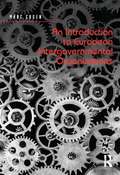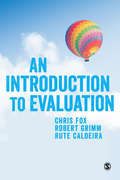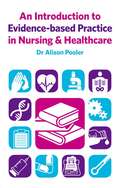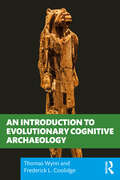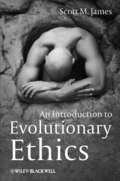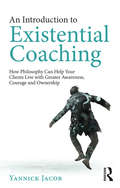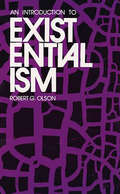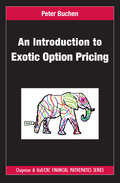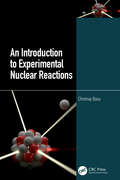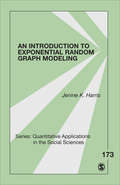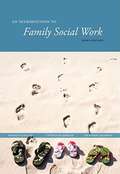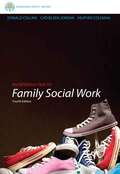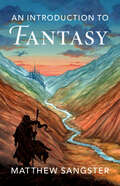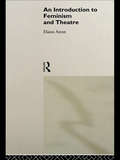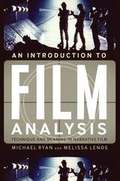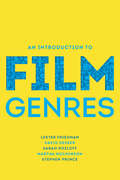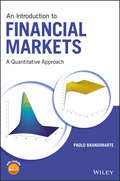- Table View
- List View
An Introduction to European Intergovernmental Organizations
by Marc CogenAn Introduction to European Intergovernmental Organizations provides an up-to-date and accessible reference to European intergovernmental organizations other than the European Union. The EU is so dominant that people often overlook the multitude of older and newer, smaller and larger intergovernmental organizations rooted in the history of contemporary Europe which continue to help shape its future. The specialized character of these organizations adds value to cooperation in Europe as a whole, creates permanent channels of communication regardless of EU membership and allows the possibility for non-European involvement through organizations such as the European Bank for Reconstruction and Development and NATO. It also allows sub regional groups of states, such as the Nordic countries or the Benelux countries to exist and express their own identity via their own organizations. This book looks at the history of Non-EU organizations, their decision-making characteristics, membership policies, legal powers actions and interactions with each other and the European Union. A uniform scheme of analysis is used to make European intergovernmental organizations comparable and by studying them we gain a deeper understanding and insight into European affairs.
An Introduction to European Law
by Robert SchützeThought-provoking and accessible in approach, this book offers a classic introduction to European law. Taking a clear structural framework, it guides the student through the subject's core elements from its creation and enforcement to the workings of the internal market. A flowing writing style combines with the use of illustrations and diagrams throughout the text to ensure the student understands even the most complex of concepts. This succinct and enlightening overview is required reading for all students of European law.
An Introduction to European Law
by Robert SchützeThought-provoking and accessible in approach, this book offers a classic introduction to European law. Taking a clear structural framework, it guides the student through the subject's core elements from its creation and enforcement to the workings of the internal market. A flowing writing style combines with the use of illustrations and diagrams throughout the text to ensure the student understands even the most complex of concepts. This succinct and enlightening overview is required reading for all students of European law. Clearly sets out the key principles and central topics taught on EU law courses. Succinct overview which also indicates key debates and controversies in the field. Numerous illustrations reinforce key concepts to aid understanding.
An Introduction to Evaluation
by Chris Fox Rute Caldeira Robert GrimmBoth practical and theoretical in approach, this book is the perfect companion for student researchers and policy makers alike. It provides actionable advice for planning and implementing evaluations, while also instilling an ability to assess the evaluations of others and consider the ways in which evaluation evidence could influence policy and practice. Drawing upon a wide range of examples from policy areas like education, criminal justice, and health and social care, this book showcases how evaluation is an interdisciplinary research practice with a spectrum of applications. Each chapter contains philosophical underpinnings and applied knowledge as well as examples from published evaluations. Specific topics include how to: Choose an approach to evaluation Plan, design, and conduct evaluations Approach evaluations using theories of change Differentiate between process, impact, and economic evaluations Understand the role of quantitative and qualitative methods in data collection Use systematic reviews and other tools to assess and disseminate evaluation findings From getting started in the field to turning evidence into policy, this book will guide you through every step of the evaluation process.
An Introduction to Evaluation
by Professor Chris Fox Rute Caldeira Robert GrimmBoth practical and theoretical in approach, this book is the perfect companion for student researchers and policy makers alike. It provides actionable advice for planning and implementing evaluations, while also instilling an ability to assess the evaluations of others and consider the ways in which evaluation evidence could influence policy and practice. Drawing upon a wide range of examples from policy areas like education, criminal justice, and health and social care, this book showcases how evaluation is an interdisciplinary research practice with a spectrum of applications. Each chapter contains philosophical underpinnings and applied knowledge as well as examples from published evaluations. Specific topics include how to: Choose an approach to evaluation Plan, design, and conduct evaluations Approach evaluations using theories of change Differentiate between process, impact, and economic evaluations Understand the role of quantitative and qualitative methods in data collection Use systematic reviews and other tools to assess and disseminate evaluation findings From getting started in the field to turning evidence into policy, this book will guide you through every step of the evaluation process.
An Introduction to Evidence Science
by Baosheng ZhangThe book discusses the subject and scope of evidence science and puts forward the new epistemological formula of "practice-evidence-knowledge-evidence-practice", which applies to the problem of evidence reasoning and knowledge acquisition that exist in different disciplines. Also, it demonstrates the history of evidence science and reveal the formation, development and maturing process of the traditional evidence theory, as well as the ideological origin and characteristics; clarifies the probabilistic path of judicial proof by probability theory of evidence. It introduces the theory of evidential reasoning, discusses the concept, nature and function the evidential reasoning through chart method, narrative method, the mixed methods and argumentation and story. It puts forward the basic principle in seeking for the truth through evidence-based decision-making. The game-theory rules and models are introduced, as well as the influencing factors of evidence-based decision-making such as fact, evidence, law and claims. It discusses the issues of evidential evaluation in both the general context and legal context, taking the decision-making activities as the frame of reference; discusses the trend of interdisciplinary development of narratology and the resulting “narrative turn” in evidence science through reviewing general theory of narratology. The book introduces the theory of evidential explanation. It analyses the relationships among fact, evidence and explanation from the perspective of hermeneutics; and theory of scientific evidence, discuss the effects of scientific evidence in judicial fact-finding. This book is the research results of the "Evidence Science Theory System and Applied Research" project, which established in 2006 and, after 13 years, has taken a significant first step in the field of a broadly defined evidence science on the basis of a less expansive research endeavor aimed at integrating evidence law and forensic science.
An Introduction to Evidence-based Practice in Nursing & Healthcare
by Alison PoolerThe beginner's guide to Evidence-based Practice for Nursing, Health and Social Care.An Introduction to Evidence-based Practice in Nursing & Health aims to help students, educators, mentors and professionals to make sense of knowledge derived from research and how to use it as a basis for making sound decisions about patient care. Covering everything from basic terminology to the application of Evidence-based Practice in your everyday routine, this text is the guide to better practice.Written in a accessible and interactive style, An Introduction to Evidence-based Practice in Nursing & Health clearly sets out what Evidence-based Practice is, why it is important and how you can use it successfully to improve patient care.Key Features for success in Evidence-based Practice:Simply and quickly shows you what Evidence-based Practice is and how you can use it. Helps you to develop an understanding of the policies driving Evidence-based Practice and professional development. Regular reinforcement of your learning through integrated Activities and end-of-chapter self assessment. Extensive references and suggestions for further reading and online research. Integrated Glossary keeps you up-to-date with the latest jargon.
An Introduction to Evolutionary Cognitive Archaeology
by Thomas Wynn Frederick L. CoolidgeAn Introduction to Evolutionary Cognitive Archaeology is the first concise introduction that lays out the epistemological foundations of evolutionary cognitive archaeology in a way that is accessible to students. The volume is divided into three sections. The first section situates cognitive archaeology in the pantheon of archaeological approaches and distinguishes between ideational cognitive archaeology and evolutionary cognitive archaeology. This is followed by a close look at the nature of cognitive archaeological inferences and concludes with brief summaries of the major methods of evolutionary cognitive archaeology. The second section of the book introduces the reader to a variety of cognitive phenomena that are accessible using the methods of cognitive archaeology: memory, technical cognition, spatial cognition, social cognition, art and aesthetics, and symbolism and language. The third section presents a brief outline of hominin cognitive evolution from the perspective of evolutionary cognitive archaeology. The authors divide the archaeological record into three major phases: The Bipedal Apes—3.3 million-1.7 million years ago; The Axe Age—1.7 million-300,000 years ago; and The Emergence of Modern Thinking—300,000–12,000 years ago. An Introduction to Evolutionary Cognitive Archaeology is an essential text for undergraduate students, graduate students, and scholars across the behavioral and social sciences interested in learning about cognitive archaeology, including psychologists, philosophers, anthropologists, and archaeologists.
An Introduction to Evolutionary Ethics
by Scott M. JamesOffering the first general introductory text to this subject, the timely Introduction to Evolutionary Ethics reflects the most up-to-date research and current issues being debated in both psychology and philosophy. The book presents students to the areas of cognitive psychology, normative ethics, and metaethics. The first general introduction to evolutionary ethics Provides a comprehensive survey of work in three distinct areas of research: cognitive psychology, normative ethics, and metaethics Presents the most up-to-date research available in both psychology and philosophy Written in an engaging and accessible style for undergraduates and the interested general reader Discusses the evolution of morality, broadening its relevance to those studying psychology
An Introduction to Excel VBA Programming: with Applications in Finance and Insurance
by Guojun GanExcel Visual Basic for Applications (VBA) can be used to automate operations in Excel and is one of the most frequently used software programs for manipulating data and building models in banks and insurance companies. An Introduction to Excel VBA Programming: with Applications in Finance and Insurance introduces readers to the basic fundamentals of VBA Programming while demonstrating applications of VBA to solve real-world problems in finance and insurance. Assuming no prior programming experience and with reproducible examples using code and data, this text is suitable for advanced undergraduate students, graduate students, actuaries, and financial analysts who wish to learn VBA. Features: Presents the theory behind the algorithms in detail Includes more than 100 exercises with selected solutions Provides VBA code in Excel files and data to reproduce the results in the book Offers a solutions manual for qualified instructors
An Introduction to Existential Coaching: How Philosophy Can Help Your Clients Live with Greater Awareness, Courage and Ownership
by Yannick JacobIn An Introduction to Existential Coaching Yannick Jacob provides an accessible and practical overview of existential thought and its value for coaches and clients. Jacob begins with an introduction to coaching as a powerful tool for change, growth, understanding and transformation before exploring existential philosophy and how it may be integrated into coaching practice. The book goes on to examine key themes in existentialism and how they show up in the coaching space, including practical models as well as their application to organisations and leadership. Jacob concludes by evaluating ethical dimensions of working existentially and offers guidance on how to establish an existential coaching practice, including how to gain clients and build relationships with strategic partners. With reflective questions, exercises, interventions and activities throughout, An Introduction to Existential Coaching will be invaluable for anyone wanting to live and work at greater depth or to succeed as an existential coach. Accessibly written and with a wide selection of references and resources, An Introduction to Existential Coaching is a vital guide for coaches in training as well as an inspiring addition to the repertoir of experienced practitioners. It serves academics and students to understand existential philosophy and allows professionals with coaching responsibilities to access more meaningful conversations.
An Introduction to Existentialism
by Robert G. OlsonIndispensable guide to one of the most influential thought systems of our century. Stressing the work of Heidegger and Sartre, it offers a careful and objective examination of the existentialist position and values -- freedom of choice, individual dignity, personal love, creative effort -- and answers to the eternal questions of the human condition.
An Introduction to Exotic Option Pricing (Chapman And Hall/crc Financial Mathematics Ser.)
by Peter BuchenIn an easy-to-understand, nontechnical yet mathematically elegant manner, An Introduction to Exotic Option Pricing shows how to price exotic options, including complex ones, without performing complicated integrations or formally solving partial differential equations (PDEs). The author incorporates much of his own unpublished work, including ideas
An Introduction to Experimental Nuclear Reactions
by Chinmay BasuAn Introduction to Experimental Nuclear Reactions is a book with a concise and simple approach to the subject of experimental nuclear physics. The subject being very technical, it is dealt with in a lucid way so that the reader can grasp the concept and later gain hands-on experience while doing fieldwork. In this book, theoretical, experimental and instrumentation aspects are covered with an emphasis on accelerator-based techniques, which form the basis for the subject of experimental nuclear physics. Other books on similar topics either concentrate on the physics aspects or are more focussed on the instrumentation and radiation detection techniques while accelerator-related concepts are less explained. One of the main standalone features of the book is its to-the-point approach so that the beginner is not lost in the never-ending details. This book discusses the following aspects: Basic introduction to nuclear reactions Two- and three-body kinematics Accelerator-based experimental techniques Basic aspects of the accelerator and accessories Vacuum physics Radiation detector physics and its associated electronics Theoretical modelling and errors This book is mainly intended for students who aspire to pursue a career in experimental nuclear physics research or work in a nuclear accelerator laboratory. Chinmay Basu, PhD, is a researcher in the field of experimental nuclear physics, and his present interests are in the field of low-energy nuclear astrophysics. He is a professor and head of an accelerator facility at the Saha Institute of Nuclear Physics, Kolkata, India.
An Introduction to Exponential Random Graph Modeling
by Jenine K. HarrisThis volume introduces the basic concepts of Exponential Random Graph Modeling (ERGM), gives examples of why it is used, and shows the reader how to conduct basic ERGM analyses in their own research. ERGM is a statistical approach to modeling social network structure that goes beyond the descriptive methods conventionally used in social network analysis. Although it was developed to handle the inherent non-independence of network data, the results of ERGM are interpreted in similar ways to logistic regression, making this a very useful method for examining social systems. Recent advances in statistical software have helped make ERGM accessible to social scientists, but a concise guide to using ERGM has been lacking. An Introduction to Exponential Random Graph Modeling, by Jenine K. Harris, fills that gap, by using examples from public health, and walking the reader through the process of ERGM model-building using R statistical software and the statnet package.
An Introduction to Family Social Work
by Catheleen Jordan Heather Coleman Don CollinsThis text is intended for Methods/Practice with Families (Mezzo) courses in Social Work as a basic primer that introduces students to an overview of practice with families. It can also be used in Generalist Practice courses in which instructors want to emphasize work with families. Likewise, it is appropriate for paraprofessional, two-year human services programs.
An Introduction to Family Social Work
by Donald Collins Catheleen Jordan Heather ColemanAN INTRODUCTION TO FAMILY SOCIAL WORK, Fourth Edition provides a strong foundation in the concepts and skills you will need to succeed in practice with families. The book offers engaging case studies, end-of-chapter exercises, illustrations, and graphics to familiarize you with the topics at hand.
An Introduction to Feminism
by Lorna FinlaysonAs well as providing a clear and critical introduction to the theory, this refreshing overview focuses on the practice of feminism with coverage of actions and activism, bringing the subject to life for newcomers as well as offering fresh perspectives for advanced students. Explanations of the main strands to feminism, such as liberalism, sit alongside an exploration of a range of approaches, such as radical, anarchist and Marxist feminism, and provide much-needed context against which more familiar historical themes may be understood. The author's broad and inclusive view conveys the diversity and disagreement within feminism with accessible clarity. The analysis of key terms equips readers with a critical understanding of the vocabulary of feminist debates that will be invaluable to undergraduate students.
An Introduction to Feminism and Theatre
by Elaine AstonAt last an accessible and intelligent introduction to the energising and challenging relationship between feminism and theatre. In this clear and enlightening book, Aston discusses wide-ranging theoretical topics and provides case studies including: * Feminism and theatre history * `M/Othering the self': French feminist theory and theatre * Black women: shaping feminist theatre * Performing gender: a materialist practice * Colonial landscapes Feminist thought is changing the way theatre is taught and practised. An Introduction to Feminism and Theatre is compulsory reading for anyone who requires a precise, insightful and up-to-date guide to this dynamic field of study.
An Introduction to Film Analysis: Technique and Meaning in Narrative Film
by Michael Ryan Melissa LenosAn Introduction to Film Analysis combines an introduction to filmmaking technique with rigorous and comprehensive training in film interpretation. Composed in an accessible style yet conversant with the latest, most advanced critical theories and methods, this innovative textbook can be reliably used on both the undergraduate and the graduate level. The book begins with chapters that familiarize students with the basic components of film technique. It connects technique to meaning and demonstrates, through numerous examples, how particular uses of film technique generate different meanings. Students will learn how films are made and how values are promoted, ideas communicated, and rhetorical arguments advanced through film technique. The second part of the book covers a range of interpretive methods, theories, and concerns. In each section, the author offers a sample reading of a film, followed by an "interpretive exercise" with suggestions for students to use in performing their own film interpretation. Carefully structured, beautifully written, and illustrated throughout, An Introduction to Film Analysis provides a thorough grounding in the subject for students around the world.
An Introduction to Film Genres (First Edition)
by Sarah Kozloff Stephen Prince David Desser Lester Friedman Martha NochimsonA brisk, accessible, and informative introduction to film genres. An Introduction to Film Genres, written by leading film scholars specifically for undergraduates who are new to the study of film, provides an introduction that helps students see thirteen film genres in a new light---to help them identify the themes, iconography, and distinctive stylistic traits of each genre. This purchase offers access to the digital ebook only
An Introduction to Film and TV Production: From Concept to Market
by Karen Russell Tameka Winston Joseph Richie Airielle J. TaylorThis streamlined, step-by-step guide provides students and newcomers in the field of media with an overview of the complete production process, from conceiving of an idea to marketing the final product. Readers will learn what it takes to create a concept, develop it, and then market and sell it. Chapters discuss pitching, producing, marketing visionary concepts, financing, and distributing content. Focused on traditional and non-traditional platforms including social media, websites, and online advertising, this book explores currently evolving media platforms, ideas, and practices and provides examples of how to navigate these unique creative processes. Interviews with business executives offer insider tips and tricks to creating a marketable project. In this book, you will learn how to: Distinguish between a "great idea" and a "marketable idea." Condense your concept into an effective "elevator pitch." Build a basic business plan. Create a marketing strategy, be it traditional, digital, or both. Establish a personal brand and portfolio that will grab the right attention. This book will be of great help to the student, independent filmmaker, and content creator looking to understand the process of getting their work produced, distributed, and marketed.
An Introduction to Financial Markets and Institutions
by Bruce Brown Maureen Burton Reynold F. NesibaCompletely revised and updated to include the ongoing financial crisis and the Obama administration's programs to combat it, this is the best available introductory textbook for an undergraduate course on Financial Markets and Institutions. It provides balanced coverage of theories, policies, and institutions in a conversational style that avoids complex models and mathematics, making it a student-friendly text with many unique teaching features. Financial crises, global competition, deregulation, technological innovation, and growing government oversight have significantly changed financial markets and institutions. The new edition of this text is designed to capture the ongoing changes, and to present an analytical framework that enables students to understand and anticipate changes in the financial system and accompanying changes in markets and institutions. The text includes Learning Objectives and end-of-chapter Key Words and Questions, and an online Instructor's Manual is available to adopters.
An Introduction to Financial Markets: A Quantitative Approach
by Paolo BrandimarteCOVERS THE FUNDAMENTAL TOPICS IN MATHEMATICS, STATISTICS, AND FINANCIAL MANAGEMENT THAT ARE REQUIRED FOR A THOROUGH STUDY OF FINANCIAL MARKETS This comprehensive yet accessible book introduces students to financial markets and delves into more advanced material at a steady pace while providing motivating examples, poignant remarks, counterexamples, ideological clashes, and intuitive traps throughout. Tempered by real-life cases and actual market structures, An Introduction to Financial Markets: A Quantitative Approach accentuates theory through quantitative modeling whenever and wherever necessary. It focuses on the lessons learned from timely subject matter such as the impact of the recent subprime mortgage storm, the collapse of LTCM, and the harsh criticism on risk management and innovative finance. The book also provides the necessary foundations in stochastic calculus and optimization, alongside financial modeling concepts that are illustrated with relevant and hands-on examples. An Introduction to Financial Markets: A Quantitative Approach starts with a complete overview of the subject matter. It then moves on to sections covering fixed income assets, equity portfolios, derivatives, and advanced optimization models. This book’s balanced and broad view of the state-of-the-art in financial decision-making helps provide readers with all the background and modeling tools needed to make “honest money” and, in the process, to become a sound professional. Stresses that gut feelings are not always sufficient and that “critical thinking” and real world applications are appropriate when dealing with complex social systems involving multiple players with conflicting incentives Features a related website that contains a solution manual for end-of-chapter problems Written in a modular style for tailored classroom use Bridges a gap for business and engineering students who are familiar with the problems involved, but are less familiar with the methodologies needed to make smart decisions An Introduction to Financial Markets: A Quantitative Approach offers a balance between the need to illustrate mathematics in action and the need to understand the real life context. It is an ideal text for a first course in financial markets or investments for business, economic, statistics, engineering, decision science, and management science students.
